On Monday, June 5 at 4 p.m., on World Environment Day
the Embassy of Italy to the Holy See opened the photo exhibition
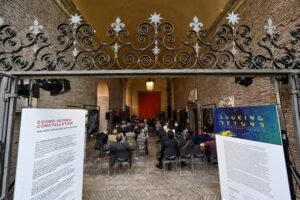
“Looking Beyond”
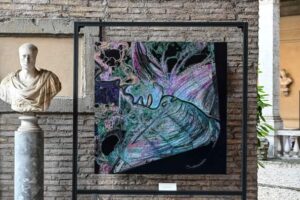
curated by Filippo Maggia and promoted by the Italian Ministry of Foreign Affairs and International Cooperation in partnership with the Italian Space Agency (ASI) and Telespazio
“Looking beyond” is an exhibition in which contemporary photography, art and technological innovation help us to go beyond a partial and limited vision of the world, projecting us into a broader perspective that reveals the beauty and – at the same time – the fragility of the Earth, leading us to rethink the way we interact with Creation”
Ambassador Francesco Di Nitto declared 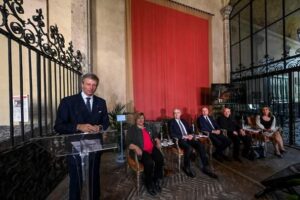
After the opening remarks the following spoke:
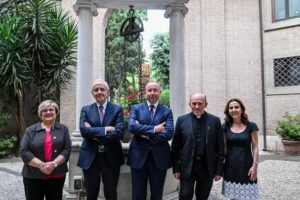
Giuseppe Pastorelli, Deputy Director General for Country Promotion, Principal Director for integrated promotion and innovation, Ministry of Foreign Affairs and International Cooperation; Gabriella Arrigo, Director of the International Affairs at the Italian Space Agency (ASI); Luigi Pasquali, Chief Executive Officer of Telespazio; Rev. Gabriele Gionti, S.J., Vice Director for Castel Gandolfo, Vatican Observatory Fausta Speranza, journalist at L’Osservatore Romano, moderated the event
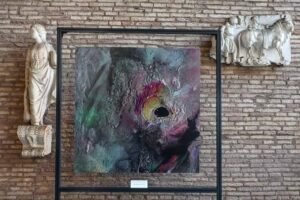 Thanks to the spectacular images
Thanks to the spectacular images
of our planet acquired by the satellites of the Italian constellation COSMO-SkyMed owned by ASI and the Italian Ministry of Defence, the project offer to the visitors an opportunity to think about the contribution of satellite technologies to Earth observation, the promotion of sustainable development and the protection of the natural and cultural heritage. The exhibition, which will be open until July 11, allows us to see the Earth from a new perspective: coloured terrestrial fragments compose different patchworks and mosaics which present the life of a city, the activity of a volcano, the history of a glacier, a forest or a desert, a desertification process, until revealing to us the existence of “hidden” places.
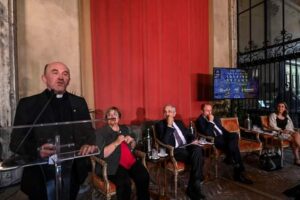 On this occasion, the scientific activity of the Vatican Observatory (Specola Vaticana) was also illustrated: it is currently the astronomical observatory and the only research institution of the Holy See. The Vatican Observatory has very ancient origins dating back to the promulgation of the Gregorian calendar in 1582. The current Vatican Observatory was re-founded in 1891 by Leo XIII with the intention of harmonizing the relationship between science and faith. Currently the Vatican Observatory has two offices, one in Castel Gandolfo on the Apostolic Palace and in the pontifical gardens and one in Tucson, Arizona, USA, with offices in the University of Arizona.
On this occasion, the scientific activity of the Vatican Observatory (Specola Vaticana) was also illustrated: it is currently the astronomical observatory and the only research institution of the Holy See. The Vatican Observatory has very ancient origins dating back to the promulgation of the Gregorian calendar in 1582. The current Vatican Observatory was re-founded in 1891 by Leo XIII with the intention of harmonizing the relationship between science and faith. Currently the Vatican Observatory has two offices, one in Castel Gandolfo on the Apostolic Palace and in the pontifical gardens and one in Tucson, Arizona, USA, with offices in the University of Arizona.
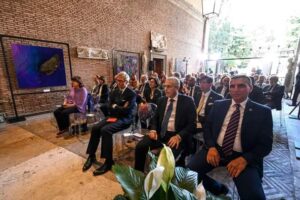
The Looking Beyond exhibition, through the richness of its images, shows the full potential of satellite technology at the service of the Planet and its citizens. We are proud to have collaborated with the Ministry of Foreign Affairs to bring this important project to more than 50 countries around the world, and we hope to be able to give our contribution again to make the world aware of Space “made in Italy”, Luigi Pasquali, Chief Executive Officer of Telespazio, said.
“Italy is strongly committed to promoting science at the service of peace and prosperity and has set itself ambitious goals in the fight against climate change. In this context, we can make use of a cutting-edge industry and a wide network of collaborations in the field of research, including the one with the Vatican Observatory”, the Vice-President of the Council of Ministers and Minister of Foreign Affairs and International Cooperation, Hon. Antonio Tajani said in his message, adding that “this cooperative approach is also at the heart of Rome’s candidacy to host the Universal Exposition in 2030. The project, entitled “People and Territories”, in fact aims to offer a platform with a universal vocation to find shared solutions to common challenges such as that of the relationship between people, communities and the environment”.
